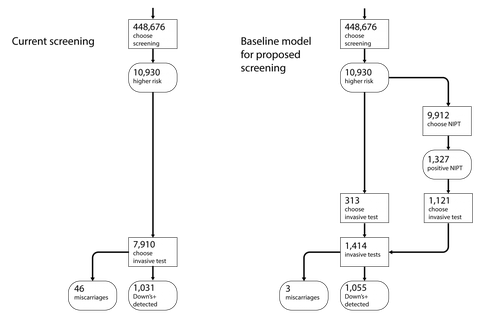The new test for Down’s syndrome
Winton Centre for Risk and Evidence Communication
News - The new test for Down’s syndrome

Recent media stories feature a new test for Down’s syndrome which the NHS is going to adopt as part of the screening programme offered to pregnant women.
The BBC quotes Department of Health statistics that the new test is estimated to save around 6,000 invasive tests a year, which would mean around 40 fewer miscarriages of unaffected babies. These estimates come from research commissioned by the National Screening Committee, which can be summarised in the graphics.
Currently around two-thirds of pregnant women receive an initial ‘triple’ test, and if the results indicate more than a 1 in 150 chance – termed higher–risk - of carrying a baby with Down’s or two other genetic syndromes (Edwards’ or Patau’s) then they are offered a definitive invasive test (amniocentesis or chorionic villous sampling): overall around 1,000 affected babies are detected by this process, but also there are around 46 miscarriages a year of unaffected babies.
Higher-risk women will now be given the option to have a non-invasive prenatal test (known as NIPT) and if this is ‘positive’, they would then be offered an invasive test. This is estimated to reduce the number of invasive tests to around 1400 a year, and only lead to around 3 miscarriages, and this the reduction has been publicised by the media. The number of affected babies that are detected is expected to remain unchanged at around 1,000 – a point that is not made in the Department of Health announcement.
An accompanying economic analysis suggests that the increased costs of the NIPT tests (around £260 per woman) would be compensated by the reduced number of invasive tests, and the overall cost per affected baby detected stays at around £14,000.